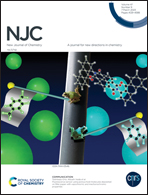Anion recognition using enhanced halogen bonding through intramolecular hydrogen bonds – a computational insight†
Abstract
Anions are associated with several biological processes in nature and act as catalysts in chemical and fuel production. Non-covalent interactions are useful tools for driving molecular processes. Recently, compounds containing halogen bond (XB) donors enhanced by hydrogen bonds (HBs) have been highlighted in the literature. Here, bonds between selected structures, capable of HB-enhanced XB (HBeXB), and anions (Cl−, Br−, and I−) have been investigated. EDA-NOCV analysis shows that increasing the X halogen donor atom (Cl < Br < I) or decreasing the X− anion (I− > Br− > Cl−) sizes favors C–X⋯X− non-covalent interactions. Molecules containing HBeXB interact more favorably with anions because of more attractive electrostatic and/or less intense Pauli repulsion C–X⋯X− interactions. The electron-acceptor groups (–NO2) present in the receptor structure support more attractive non-covalent bonds with Cl−. This is because the C–X bond is polarized by the –NO2 group and/or N–H⋯I interaction. The improvement from a mono to double HBeXB system favors anion recognition due to more attractive C–I⋯(Cl−, Br− or I−) bonds polarized through N–H⋯I interactions. Our results contribute significantly to gain further insight into the mechanism of action of compounds with anion sensing properties, aiding in the design of compounds with improved properties.



 Please wait while we load your content...
Please wait while we load your content...